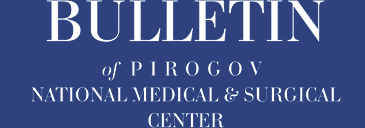Authors
Babich A.I.1, 6, Gurgenidze V.V.2, Khubezov L.D.3, Osipov A.V.4, Zavrazhnov A.A.5, Demko A.E.1
1 St. Petersburg Research Institute named after I. I. Dzhanelidze, St. Petersburg
2 Branch №1 of the Federal State Budgetary Institution "1472 VMKG", Sevastopol
3 Branch №4 of FGKU "1602 EKG", Lugansk
4 Federal Center for Disaster Medicine. FSBI "NMHC named after N. I. Pirogov" Ministry of Health of the Russian Federation
5 MMC VT LLC, St. Petersburg
6 MCHU DPO «Clinic Medex» Sevastopol
Abstract
Rationale: Vascular injuries are the main cause of mortality and disability in military and civilian injuries. With a massive influx of wounded, there is no time for high-tech and long-term operations. The search for new effective ways to increase the viability of a limb segment damaged with an artery for transporting the wounded to the next stage of medical care seems extremely relevant.
Objective: to develop a technique for regional perfusion and preservation of the pelvis and lower extremities, followed by their inclusion in the systemic circulation, as well as to conduct preclinical tests of the developed method on laboratory animals (female minipigs).
Materials and methods: An experimental study was conducted on four minipigs, females weighing 40 ± 5 kg each and aged 4-8 months. Perfusion and preservation of the pelvis and lower extremities, followed by their inclusion in the systemic circulation in experimental animals, was performed according to an original, independently developed technique. During the procedure, invasive monitoring of blood pressure, heart rate, control of diuresis, acid-base state in arterial blood was performed, neuromyography of the muscles of the lower extremities, Doppler sonography and pathoanatomical examination of tissue samples of a laboratory animal at time points were performed.
Results: In all four cases of the experiment, the planned surgical intervention was successfully performed and completed. There were no changes detected by Doppler sonography after the start of blood flow in the previously disabled anatomical segment. The amplitude of the bioelectric activity of the muscles before switching off from the systemic circulation, as well as 30 and 60 minutes after switching on the previously isolated anatomical segment did not differ. The assessment of histological changes in the striated muscles of the isolated anatomical segment, as well as liver, lung and kidney tissue after the inclusion of the disconnected segment in the systemic circulation showed the absence of necrobiotic changes in tissues and the absence of signs of reperfusion damage in the kidneys, liver and lungs.
Conclusion: The use of isolated perfusion before preservation and subsequent washing of the contour of isolated perfusion before including the anatomical segment in the systemic circulation avoids the development of reperfusion injuries. The developed technique is safe and effective, allows you to maintain the viability of the pelvic and limb muscles for 5 hours and can be used in clinical practice.
Keywords: isolated perfusion, limb preservation.
References
1. Dubrov VJe, Gerejhanov FG, Koltovich AP. Ranenija magistral'nyh sosudov pri boevyh termomehanicheskih povrezhdenijah. Politravma. 2020; 4: 23-29. (In Russ.) doi: 10.24411/1819-1495-2020-10042.
2. Reva VA, Potjomkin VD, Baranov MI, Ershov EN, Tatarincev SA, Seleznjov AB. Vremennaja jekstrakorporal'naja perfuzija – al'ternativnaja tehnika podderzhanija zhiznesposobnosti konechnosti pri povrezhdenii magistral'nyh arterij (jeksperimental'noe issledovanie). Angiologija i sosudistaja hirurgija. Zhurnal imeni akademika A.V. Pokrovskogo. 2023; 29(4): 108-119. (In Russ.) doi: 10.33029/1027-6661-2023-29-4-108-119.
3. Kruit AS, Smits L, Pouwels A, et al. Ex-vivo perfusion as a successful strategy for reduction of ischemia-reperfusion in-jury in prolonged muscle flap preservation – a gene expres-sion study. Gene. 2019; 701: 89-97. doi: 10.1016/j.gene.2019.03.021.
4. Ng ZY, Lellouch AG, Drijkoningen T, Chang IA, et al. Vascularized composite allotransplantation – an emerging concept for burn reconstruction. Journal of Burn Care & Research. 2017; 38(6): 371-378. doi: 10.1097/BCR.0000000000000532.
5. Müller S, Constantinescu M, Kiermeir D. Ischemia/reperfusion injury of porcine limbs after extracorporeal perfusion. J Surg Res. 2013; 181: 170-182. doi: 10.1016/j.jss.2012.05.088.
6. Rohde E, Goudarzi M, Madajka M. Metabolic profiling of skeletal muscle during ex-vivo normothermic limb perfusion. Mil Med. 2021; 186: 358-363. doi: 10.1093/milmed/usaa268.
7. Kueckelhaus M, Fischer S, Sisk G. A mobile extracorporeal extremity salvage system for replantation and transplantation. Ann Plast Surg. 2016; 76: 355-360. doi: 10.1097/SAP.0000000000000681.


